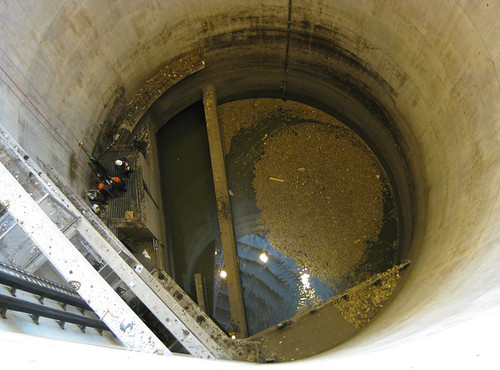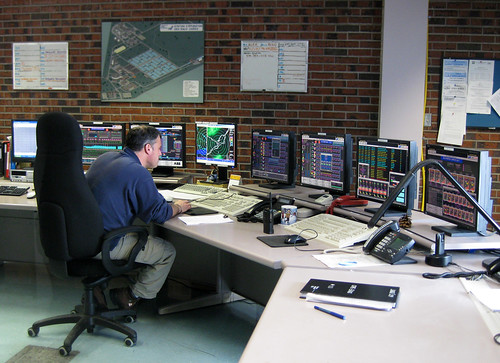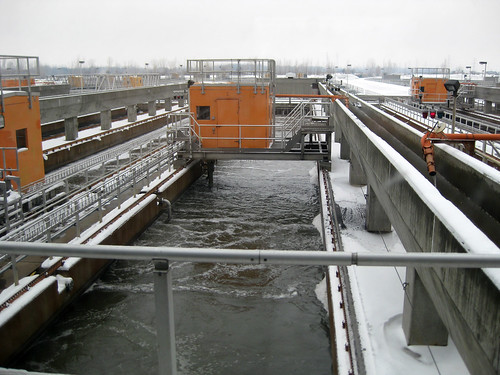Living in a city, I find it disturbingly easy to remain blissfully unaware of the resources we use and the wastes we produce. So I jumped at the opportunity to take a free tour of the facility yesterday, tagging along with a friend researching her thesis.
My first surprise was that Montreal’s waste water treatment facility is the third largest in the world. Why such a massive poop-processing plant for a rather small city like ours?
Map of sewer collectors and territory served by combined sewers (beige) and separated sewers (green) from the document Réseau D’Interception (pdf), provided by the Station de l’épuration des eaux usés, CUM, 1999.
Turns out there are a few reasons: first because we’ve only got one waste water treatment plant for the entire island (Toronto’s got 4). Before this baby kicked into gear in 1984, our toilets and drains flushed directly into into the St-Lawrence river. When they built the collector, they basically ran a big pipe around the island, intercepting the 180 different outflow points of local sewers and detouring the waste to the treatment plant.
The sewage flows from West to East, following the natural slope of the land, and gravity does all the work. By the time it reaches Pointe-aux-Trembles, the collector is about the width of a metro tunnel and 46 m underground. Pumping it up to the surface racks up a $12-million electricity bill each year.
At the plant, water from the main collectors pools in 4 massive wells.
The second reason for our enormous plant is that Montreal’s facility handles 4 times more volume per capita than most European plants, and about 1.5 times more than Toronto. That’s partially because we tend to be water hogs even by Canadian standards, and partly because 63% of our territory still functions with combined sewers, which means that toilet water and industrial waste mixes rain water in the sewers, and the the whole lot ends up at the treatment plant. Household waste water makes up only a quarter of the volume and rainwater accounts for 15%.
Here’s the next big surprise: according to our guide, about a third of the “waste water” they receive is actually freshly-purified water that escapes through Montreal’s notoriously leaky pipes that leeches into storm sewers. So not only does the city lose 40% of our purified drinking water due to leaky pipes, it also has to handle an extra 33% at the waste water end of things.
Combined sewers come with a second big problem. If the collector or the pumps reach capacity, which can happen during a heavy storm, sewage has to be released directly into the surrounding waters. Since it was overcast during our visit, the operator had en eye on McGill’s weather radar (fourth monitor from the right in the picture above). If necessary, he would decide when and where to release the sewage.
In this basin, salts are allowed to sediment out of the water.
The treatment process itself is pretty straight forward: pump, filter, sediment, add coagulant, sediment some more, and then flush. This deals with solids, salts, phosphorus, and heavy metals, but what about bacteria and other organic chemicals? To put it bluntly, what about the poop?
Well, its a pretty big river, says the guide, it gets pretty diluted.
Montreal dosen’t use any biological treatment or disinfectant like they do in Toronto (pdf). Our guide explains that, given how dilluted our sanitary waste is in rain and fresh water, it wouldn’t be practical. However, before flowing back into the Saint-Lawrence river the treated water runs through one last building where secondary treatments such as ozonation could some day take place. We don’t visit that one though – it’s empty.





13 comments
By coincidence, I was just reading an article in the New York Times about urine diversion toilets, “Yellow is the New Green”. It can be found here:
http://www.nytimes.com/2009/02/27/opinion/27george.html?scp=1&sq=urine%20toilet%20china&st=cse
Great post!
I have to say one thing in favor of combined sewers.
While it may seem absolutely awful to process all that crystal clean rainwater that’s falling out of the sky and onto our heads, and ultimately into our sewer system, you certainly must keep in mind that… we live in the city.
Since the rain is falling onto asphalt and concrete in a city that, as clean as we may think it is, is just plain dirty, the rain is whisking away everything in it’s path and straight into the storm drains. This includes trash items, hydrocarbons and other chemicals, dust and rock particles, organic matter of all kinds. So the rain turns to a chemical soup once it hits the ground and makes it’s way to the processing plant.
So let’s say we kept the storm drains in a separate system and let all that crap go straight into the St-Lawrence, I can guarantee that we wouldn’t find many fishes swimming around the outlet pipe.
So to me, a combined system IN A CITYSCAPE is a must. If you have a farm or other type of house in the country, that’s a whole different story because there are not as many contaminants on the ground and there is actually soil available to filter anything out before rainwater reaches it’s outlet (river or lake).
Thanks for an interesting article though! Hard to believe we were dumping all that poop into the river for so long! Ugh!
Sewage and runoff is not the only thing that goes into the sewer system.
Throught out the city are ‘Snow Holes’ where snow from dump trucks is dumped into trunk sewers, the openings covered with hinged steel plates.
http://i17.photobucket.com/albums/b61/SDR_North/SnowDumpingHoleoverTrunkSewerSiteFo.jpg
The photo above is just a few yards East of where the Montreal Tramways Ahuntsic Station once was, just East of rue Millen North of Henri Bourassa.
The Henri Bourassa Metro Station is visible in the distance.
The two Snow Holes at this location are visible at maps.live.com
There was another ‘Snow Hole ‘on Cote St. Luc in the vicinity of West Hill High, but I cannot now recall the exact intersection.
For quite some time the City had open a sort of ‘mine entrance’ on the North East corner of Cavendish and Monkland and trucks were constantly travelling in and out.
I assume there was a Trunk Sewer down below travelling beneath Cavendish??
For years in the park at this location, North of Monkland and the Benny Farm Appartment complex was a public stage/bandstand.
The Benny Farm complex was heated by steam, and there was a stationary boiler house in the centre of the complex East of Cavendish.
On cold winter days steam could be seen rising from pipes at corners of the appartment blocks.
After they removed the streetcars from the Lachine route, the abandoned right of way lay fallow for a year or so, rails removed, copper trolley wire drooping between supports.
C. 1959 they dug a great trench along the old Tramways route, and put in pipes, which I presume were additions to the system.
Snow was once piled high in the park at Chester and Coronation in NDG until neighbours on Coronation claimed the vibrations from bulldozers used to push the snow into mountains cracked the plaster in their homes.
In the early Fifties, just after Christmas, Christmas trees were trucked to this same park and piled high, just off Cote St Luc road, and lit afire in a grand blaze.
For a while in the Sixties snow was trucked down the steep hill East of Rose Bowl Lanes at Cavendish and Upper Lachine into by-then-abandoned Turcot Yard and allowed to melt into Riviere St Pierre.
Thanks for the info! We should all know that stuff, shouldn’t we?
About the snow piles, great comments Cdnlococo!
I was surprised to notice that very little snow has been piled onto the Turcot Yards this winter. And even more surprised to see that they piled it all onto the other side of the 20 instead!
I don’t quite remember what was standing there before but it’s obviously industrial lots. If you go by there, take a look at those snow piles, it’s rather impressive, as are the huge snow blowers that take the snow from down low and belch it up into the air to reach the top of the pile (which must be at leat 6-7 stories high!).
Another interesting fact about snow blowing and snow disposal is that it isn’t so long ago that municipalities still had the right to blow or truck snow directly INTO our lakes and waterways! It was outlawed by the Environment Ministry in 1998 only! Imagine all that dirty and especially salty snow going straight into the waterways, it’s insane!
Admittedly, some municipalities still do this sort of thing but the Environment Ministry keeps an eye on them and so it is certainly not common practice anymore. They must now dispose of the snow in certified lots on their territory.
Cheers!
We shouldn’t be defecating in our water supply, in any case. It’s an antiquated and extremely expensive way to dispose of one’s waste. The would city would save billions, not to mention clean up the very waterways the island sits in, if it instituted a compostable toilet system.
However, that would also require large manufacturers to stop disposing of their toxic waste in the sewage system as well. Manufacturers use more water – and pollute more water – than residences do. The reticence to hold corporations accountable for their own waste water treatment is the primary reason the city is unlikely to make the bold move and stop, for lack of better words, shitting in our own water supply.
Until the Fifties with the increase in the amount of automobiles on public roads, salt and sand were used sparingly, if at all.
Until the end of WWII, sleighs were still common for commerce, and sand etc. would hinder their progress.
Most peolpe who hard autos put them away for the winter and took the streetcar, or taxis.
Cars and trucks that did venture out had to have chains. WWII resulted in rationing on tires and fuel.
As most homes and commercial buildings burned coal or coke, ashes were put curbside into separate containers and haulled away in ash trucks, as in getting your ashes haulled.
The ashes were used on the streets and dumped in piles.
Garbage went in separate trucks well into the Fifties, and these were just plain dump trucks with two men on the sidewalk and one inside the dump who packed down the garbage with his feet.
Once most clients switched to oil, ashes went in garbage trucks, sometimes starting fires.
In summer, we heated our sink and bath water with a coal heater in the basement. In winter, the main furnace, which burned coke, heated the radiators and the bath water on separate circuits.
There was a special screen rocker which separated the ash, clinker and still-good coke or coal from the ash pit of the furnace.
Ash from coal and coke was a sort of orange/red in colour, and can still be seen from time to time when power shovels are excavating old areas for new construction.
Montreal Tramways used to plow city streets their routes were on with electric snowplows.
Once the City started to plow snow in earnest, snowblowers then blew the snow, sand and grit onto private lawns, making a big ugly iceberg that would not melt well into spring.
The lawn had to be raked before it would grow, and you would find all the missing hickey sticks, gloves and chewed-up toy sleighs that had gone missing.
By 1960 or so snowblowers were putting snow into trucks instead.
When the City was using the ‘Snow Hole’ on Cote St Luc, they would block of a portion of the street and dump the snow into the hole direct, or onto the street where a loader would push it into the hole from the asphalt.
C. 1963 Montreal tried out an Oil-fired Snowmelter on Patricia between Somerled and Fielding in NDG which moved in parallel with a snowblower, melted the snow in a large cauldron with oil-fed-flames beneath, then dumped the water into a curb sewer.
It was found to be too slow, and costly, and trucks stayed in use.
Montreal West had a stationary Snowmelter in thier City Works Yard c. 1966.
To clean outdoor hockey rinks, City of Montreal had a fleet of small gasoline sidewalk-size tractor-mounted snowblowers, painted grey with red wheels which circlated from rink to rink.
One of these burned up in Cornation Park on Somerled and Coronation c. 1958.
When a hydrant froze, a City truck would arrive with a small coal-fired steam boiler on a two-wheel trailer which had a hinged smoke stack, and live steam would be let into the hydrant.
A City worker would walk around with a wrench in the winter turning the hydrant valves to see if the valve underground was frozen or not.
This is so a fire truck would not arrive at a hydrant and find no water!
If the water pipe to a home or a business froze beneath the street, the City would come with a gasoline Arc Welder and run a cable to the nearest hydrant and the other cable to the pipe inside the house at the shutoff.
Current would heat the pipe thru electric resistance, melt the ice in the pipe and water would then issue from a tap left open.
During the electric cycle, electric lamps and TVs would flicker as currents interfered with each other, the Hydro electricity using water pipe a ground.
White circles about 4 inches in diameter with black digits stencilled upon were painted on houses and poles to indicate location of water shut off valves to homes and business.
Distance measured with tape measures.
Valves were located under dirt or grass with a magnetic device carried by the valve crew.
Valve distance to shut-off stencilled on Hydrants in direction facing valve.
Other stencils in red on power poles etc, usually with a triangle showing direction, gave distance to catch basins hidden under snow.
There is a “snow hole” under the Turcot interchange across from Centre Gadbois.
Wow that was an incredibly detailed account! Thanks a bunch, fascinating stuff for someone in his late twenties such as myself!
Indeed a very informative comment, thanks!
I was also lucky enough to get a full tour of the plant as well at a Canadian Water Network workshop, studying Montreal’s water infrastructure.
http://mikechristie.wordpress.com/2008/11/03/montreals-water/
Quite a literally awesome place – massive in scope, feels like a true feat of modern engineering.
Could you please tell us who you contacted to have access to this tour? We would like to organize a tour as part of a Youth Eco Leadership Training program that we are launching this fall (water is this year’s theme).
Would be greatly appreciated. Thank you, Shelley